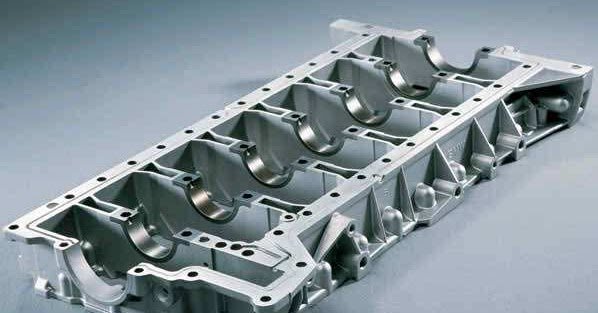What is a Bedplate of Diesel Engine ?
The bed plate forms the foundation of the engine (or constructions )on which the other structural component such as A-frame, all column, and Guides are mounted and it can withstand heavy fluctuating stresses from working parts.
Bedplate supports the Load of the Engine and it’s other Constructional parts and provide a base for the large mass.

What are the Functions of a Bed Plate ?
The functions of a bed plate, particularly in the context of marine or industrial engines, are critical for ensuring proper operation, stability, and efficiency. Here’s a consolidated overview based on your points:
- Load Transmission: The bed plate transmits the engine’s load, including the propeller thrust, to the ship’s structure. It distributes this load over an adequate area, ensuring that the crankshaft remains aligned for optimal performance.
- Oil Management: It collects crankcase lubrication oil and facilitates its return to the drain tank for recirculation, maintaining proper lubrication and cooling of engine components.
- Structural Integrity: The bed plate is bolted to the tank top, which is reinforced with thicker plates and girders to provide additional strength and stability, ensuring it can support significant forces during engine operation.
- Support Base: Acting as a foundational element, the bed plate provides essential support to the entire engine structure, contributing to the overall stability of the system.
- Static Weight Support: It bears the static weight of the entire engine and its components, ensuring that forces are effectively transferred to the ship or structure.
- Dynamic Load Support: The bed plate also supports the dynamic loads generated by the engine’s running gear, absorbing vibrations and shocks that occur during operation.
- Crankshaft Alignment: The crankshaft fits into the bed plate via main journal bearings, ensuring the crankshaft is held in perfect alignment for efficient functioning and reduced wear.
These functions collectively ensure that the engine operates smoothly, safely, and efficiently, which is crucial for the overall performance of marine vessels or industrial machinery.
What are the fundamental requirements of Bed plate ?
The fundamental requirements of a bed plate in an engine are essential to ensure its structural integrity, functionality, and efficiency. Here’s a breakdown of each requirement:
- Strength
The bed plate must have sufficient strength to bear the static and dynamic loads of the engine, including the weight of the engine components and the forces generated during operation. - Lightness
While maintaining strength, the bed plate should be designed to be as light as possible to avoid adding unnecessary weight to the overall engine structure, especially in marine and automotive applications where weight efficiency is crucial. - Toughness
Toughness is necessary to withstand impact and fatigue stresses. The bed plate must endure repeated cycles of mechanical loads without cracking or deforming, ensuring long-term durability. - Simple Design
A simple design facilitates ease of manufacturing, assembly, and maintenance. Simplicity also ensures that the bed plate remains reliable while minimizing potential points of failure. - Seal
The bed plate must be able to seal off the crankcase to prevent oil leaks and ensure that the lubrication system operates effectively, keeping contaminants out of the engine. - Access
Access points should be provided in the bed plate for inspection, maintenance, and repairs of internal components like the crankshaft and bearings, ensuring efficient engine servicing. - Dimensions
The dimensions of the bed plate must be precise, fitting the engine structure perfectly to ensure proper alignment of components like the crankshaft, and ensuring compatibility with the overall design of the engine and surrounding structure. - Rigidity
The bed plate must maintain rigidity to prevent deformation under load, ensuring that the engine structure remains aligned and that mechanical stresses are distributed evenly.
These requirements ensure that the bed plate can provide the necessary support, alignment, and durability for efficient engine operation.
Read About : Difference between two Cross head and Trunk type piston engine
Construction
Sure! Here’s a simpler breakdown of the construction of bed plates:
1. Small Engine Bed Plates
- Material: Small engines generally have bed plates made from one solid piece of cast iron.
- Design: This design is a single casting, meaning it’s all one part, making it strong and stable.
- Vibration Dampening: Cast iron helps absorb vibrations, making the engine run more smoothly.
2. Large Engine Bed Plates
- Material and Structure: Large engines use fabricated mild steel for their bed plates.
- Configuration: These have:
- Longitudinal girders: These are long beams that run the length of the bed plate.
- Cast steel transverse girders: These are shorter beams that support the crankshaft bearings, helping share the load evenly.
3. Material Requirements
- Carbon Content: For large marine diesel engines, the materials used should have low carbon content (up to 0.23%). This helps the metal stay strong and easy to work with during construction.
4. Key Points in Bed Plate Construction
- Strength and Rigidity: Bed plates must be strong enough to hold the engine without bending or breaking.
- Vibration Control: Small bed plates use cast iron to help manage vibrations; larger bed plates may need special designs to do this.
- Easy Maintenance: The bed plate should be designed so that engine parts can be easily reached for checking and repairs.
In short, the construction of bed plates is important for keeping engines stable and running smoothly, with different designs for small and large engines.
What are the forces act on bed plate
The forces are :-
- Firing pressure (Cylinder gas pressure )
- Forces of inertia of moving masses
- Side thrust due to movement of connecting rod.
- Whole weight of engine act on the bed plate.
- Torque due to rotation of propeller.
- Hull deflection.
- Vibrations forces (It is generated due to fluctuations in torque,shock loading and thermal stress )
- Rough weather (Forces due to ship’s movement in heavy seas).
Materials use
◆ Cast iron
Hybrid: fabricated mild steel for longitudinal Cast steel for transverse.
Maintenance / What are the checks to be carried on the bed plate during inspections
Since Bedplate is the base of the Engine it should be in proper order for the proper functioning of the Engine. And for that it should be regularly checked and maintenance should be carried out.
Maintaining the bed plate is crucial for the proper functioning of the engine. Regular inspections are essential to ensure its integrity and performance. Below are key checks to perform during inspections:
1. Cracks
- Common Issue: Cracks often develop over time due to prolonged use and heavy loading.
- Areas to Inspect:
- Welded Joints: Examine the areas where transverse girders connect to longitudinal girders.
- Bearing Pockets: Check under the bearing pockets for radial cracks or cracks along the pocket line.
- Tie Bolt and Bolt Holes: Look for radial cracks at tie bolts and around the holes for frame bolts.
- Lightening Holes: Inspect around the lightening holes in the bed plates and girders.
- Main Bearing Keeps: Inspect the base of the main bearing keeps for any signs of cracking.
2. Welding
- Inspection: Check the condition of welding joints, especially if recent welding has been done, ensuring there are no defects.
3. Faulty Casting
- New Deliveries: Newly delivered engines with cast components should be tested for defects in casting.
4. Corrosion
- Vulnerability: Since the bed plate is located at the lowest part of the engine, it is prone to corrosion. Inspect it for any signs of rust or degradation.
5. Loose Frame
- Impact of Loading: Loose frames can occur due to excessive loading or issues with tie rods.
- Check Tie Rods: Ensure that tie rods connecting the bed plate to the A-frame and engine entablature are tight and that no part of the bed plate is loose.
6. Faulty Holding Down Bolts
- Inspection for Tightness: The holding down bolts secure the bed plate to the ship’s bottom structure. Regularly check these bolts to ensure they are secure.
7. Oil Leaks
- Lubrication System: The bed plate is involved in storing and transferring lube oil. Inspect the bed plate and joints for any oil leaks, which can indicate issues with seals or connections.
Regular checks on cracks, welding, casting quality, corrosion, frame integrity, bolt tightness, and oil leaks are critical for maintaining the bed plate’s health and ensuring optimal engine performance.
What are the cause of breaking of bed plate ?
The breaking of a bed plate can occur due to several factors, including:
- Overloading: Excessive weight or force beyond the bed plate’s designed capacity can lead to fractures or failures.
- Uneven Loading: If engine loads are not evenly distributed, it can create stress concentrations that weaken the bed plate and cause breaking.
- Faulty Maneuvering Techniques: Incorrect handling or operation of the engine, such as abrupt changes in speed or direction, can apply undue stress on the bed plate.
- Loosened Tie Bolts: If the bolts securing the bed plate become loose, it can lead to misalignment and increased stress in certain areas, making the bed plate susceptible to breaking.
Addressing these issues through proper design, maintenance, and operation can help prevent bed plate failures.
Faults in Bedplate
Faults in a bed plate can lead to operational issues and may affect the performance of the engine. Here are some common faults:
1.Cracks: Cracks can develop due to overloading, fatigue, or manufacturing defects, compromising the structural integrity of the bed plate.
2.Oil Leaks: Oil leaks can occur from damaged seals or joints, leading to lubrication issues and potential engine damage. This can often be caused by wear or improper installation.
3.Loose Chocks: Chocks are used to secure the bed plate in position. If they become loose, they can lead to misalignment of the engine components, causing vibrations and further mechanical issues.
Regular inspections and maintenance can help identify and address these faults before they lead to serious problems.
Source : https://www.wartsila.com/encyclopedia/term/bedplate
Also Read : Fresh Water Generator On ships
Read more : Boiler Mountings
Check Out Other Important Topics
| IC Engine | Important PDFs | Boilers | Synergy Maritime Exam | Naval Arch | MEO Class 4 |
| Interview Questions | Difference Between | Types of Pumps | Auxiliary Machines | Types of Valves | Home |
